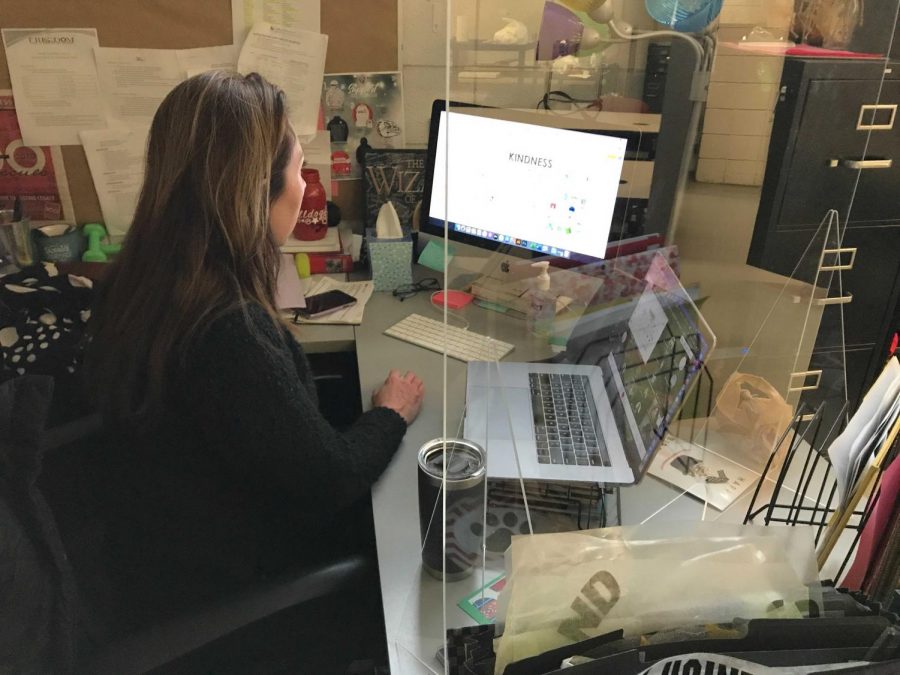Teachers find new obstacles in education during virtual learning
Students that participate in Ms. Milanovich’s classes are rewarded with points that can be redeemed for a variety of prizes.
Teachers are not robots that are programmed to assign homework. They have feelings and emotions that flow through their brains just as much as they would in a high school student’s mind. At some point during the virtual learning experience, everyone has felt a sense of frustration and distress. From the perspectives of students, it has been made known that the virtual adaptation has been a struggle and has taken a toll on their motivation tendencies and mental health. The primary focus has been making sure all students are doing well and keeping up with their work. The same amount of focus needs to be directed towards our teachers, who are experiencing everything from a different point of view. Their mental stamina and well beings are just as crucial as anyone else’s while experiencing this virtual change in education.
Teachers at Freedom have a reputation for having a genuine investment in their students’ lives. Building relationships with them is an important part of their job. Since school started virtually this year, it has been tough for teachers and students to connect and build those essential relationships.
“The virtual setting has been a challenge as it has limited my ability to get to learn the non-verbal communication style of the students,” Technology teacher Kristen Milanovich said.
The anxieties that accompany unmuting and not knowing when to jump into the conversation in a virtual setting can keep students quiet throughout the class. There isn’t the option to just pass teachers in the hallway and give them a smile or wave, it takes more of an effort to communicate and engage with teachers. When students do not attain a certain level of comfort and openness in the virtual classroom, it is harder for teachers to reach out and connect with them.
Milanovich has come up with a fun and interactive way to engage with students and encourage participation.
“As we approach Christmas break, I have now come up with a game where the students can earn points and then go “shopping” at my store which offers free homework passes to gift cards that I will purchase. Obviously the higher point items include turning their cameras on, dressing up for class and turning assignments in early! I may go broke buying gift cards, haha, but that’s a price I’m willing to pay for participation,” Milanovich said.
A key factor in whether or not teachers can bond with their students is through the heated camera debacle. More students choose to keep their cameras off for class, in comparison to the few that do. The refusal to turn on cameras results in teachers staring at profile picture icons for hours on end.
“It is not fun to teach a screen of circles! It is quite discouraging as a teacher. I would typically use expressions to determine if students were understanding the material, confused or even completely lost. When teachers don’t have the ability to use this feedback we are left guessing if students are ready to move on or if they are about to crawl under a rock and give up!” Biology teacher Samantha Circle said.
The social aspect of high school is what is missed the most about in-person learning. Not being able to physically see or laugh with classmates has been a challenging adjustment. The closest thing to normal that remote learning offers is the option for students to turn their cameras on and see their classmates. Teachers strongly encourage students to turn their cameras on, so they feel a sense of social normalcy back along with showing they are engaged in class.
“I am requiring students to have their cameras on in my class. With the update on google meet allowing students to blur their backgrounds or even insert a fun one, there is no reason not to!” Circle added.
Several teachers decided to remain virtual via their home to instruct their classes to limit the risk of COVID-19 transmission to their families. A fair amount of the FHS staff lives near Freedom, meaning if they have children, they are most likely online just as the students of Freedom are. Equally balancing the time between the students online and their children at home trying to learn virtually can be a lot to handle.
Math teacher Amanda Bovard has been teaching her classes from her home accompanied by her daughter, who is in kindergarten.
“The hardest is trying to balance the times that her meetings start with when I am teaching. So in between sessions, she is often playing behind me and needs to be reminded to be quiet or that I am teaching. If I need to step away or talk to my daughter, I try to mute my camera and mic for a brief moment. The biggest challenge has been getting her to remain quiet while I teach, mainly because of the recordings for each class,” Bovard said.
Although circumstances are not ideal, teachers are putting in their best efforts to make sure their students are receiving the best education possible. With all of the obstacles and stress teachers are inhabiting, greeting them with a smile or waving goodbye through the screen at the end of the class could brighten their day knowing that their students care for them.



